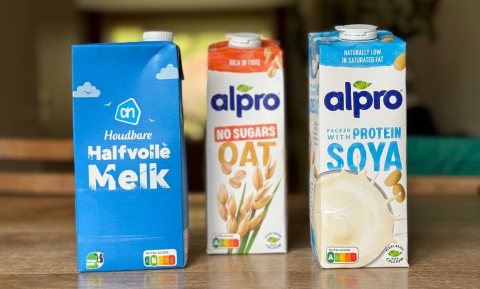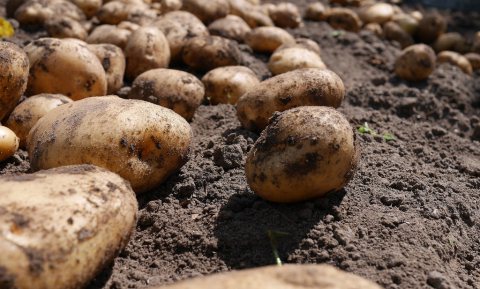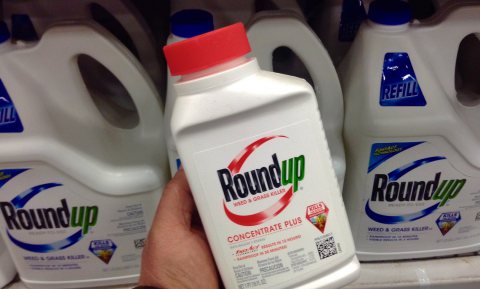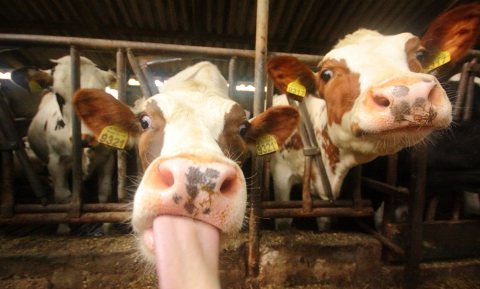Ruim twintig Masters studenten van de Radboud Universiteit (Nijmegen), afkomstig uit de hele wereld, dachten de afgelopen twee maanden na over heel uiteenlopende aspecten van voedsel in het kader van de Honours Academy. Hoe zorg je dat je er voldoende van blijft maken, dat iedereen er voldoende van kan krijgen, dat het gezond is, dat we dieren zo goed mogelijk behandelen en dat het milieu zo weinig mogelijk aangetast wordt? Je zou het voedselbeleid kunnen noemen.
We publiceren deze weken hun gedachten over verschillende onderwerpen rond voedsel. Het is uitdagend die te vergelijken met de gedachtenvorming over voedselbeleid zoals die thans in de Nederlandse Tweede Kamer plaatsvindt. Denken deze jonge mensen anders, verder of juist minder ver dan de beroepsbeleidsmakers van Nederland?
Vandaag Lieke van den Boom, Master’s student Behavioural Science. Zij denkt dat 'nudgen' kan helpen consumenten hun gedrag zodanig te laten veranderen dat ze minder voedsel verspillen. Leer hoe lelijke bananen opeens aantrekkelijke koopwaar worden als je ze maar op de juiste manier aanprijst.
Food waste has been identified as a substantial problem in the context of sustainability. Around one third of the food that is produced goes to waste, together with all the resources necessary for its production (FAO, 2016). Although food waste occurs at various stages of food production, a large part is the food waste that occurs at the market and consumption stage (40%). This indicates that a change in consumers’ behavior might already lead to a great improvement of the issue.
Whether consumers are willing to try to reduce food waste is determined by three factors: whether reducing food waste is perceived as something good, concerns about getting sick when eating leftovers and food passed the “best before” date, and the belief that one can achieve a reduction in food waste (Visschers, Wickly, & Siegrist, 2016). These intentions can be predictive of our actual behavior, whether we decide to throw something away or to still use it. However, our actual behavior related to food waste is besides our intentions also determined by less conscious factors, such as habits and emotions (Russel, Young, Unsworth, & Robinson, 2017).
Nudging might help to reduce food waste
To change behavior, nudges have become quite popular; small changes in the environment to nudge behavior in an anticipated direction without excluding other behavior (Thaler & Sustein, 2008 as cited in Marchiori, Adriaanse, & De Ridder, 2017). There are two kinds of nudges that might be useful in reducing food waste: subtle nudges that we are not aware of but that direct behavior in the particular context, and nudges that we are aware of and might direct behavior plus help to create intentions to perform similar behavior in another context. The subtle nudges can through responding to unconscious processes contribute to a reduction of food waste. For example, using smaller plates for serving food in a restaurant and conveying the norm that it is okay to make use of the buffet several times, cuts down the food waste significantly by 20% in this specific context (Kallbekken & Sælen, 2013). However, this reduction in food waste might remain specific to this situation and not direct behavior in another situation (Marchiori et al., 2017).
Because intentions also contribute to the reduction of food waste, it might be more fruitful to use less subtle nudges to create positive attitudes towards reducing food waste and empower people to achieve a reduction in food waste. For example, researchers tried to promote the sale of imperfect fruit, in this case bananas with some blemishes, by presenting the fruit in combination with different signs from “I might not have the looks, but I am super tasty! Convince yourself!” to “Grab me! Too good to waste. For the sake of the environment!” and “Get me for a special price! Save money!” (Rohm et al., 2017). When the imperfect bananas were presented with the reference to the environment, framing buying the bananas as a sustainable choice, more of these imperfect bananas were taken. This sign was even more effective than lowering the price of the banana. This intervention not only directly reduces food waste but might also help disrupt the habit of searching for the most perfect piece of fruit (Russell et al., 2017) and give insight in which choices matter for producing food waste and how our individual choices contribute.
Nudges are observed to be helpful in promoting healthy choices and in a similar manner it might be helpful in promoting the sale of imperfect fruit and vegetables in the supermarket or the use of overripe fruit and vegetables and leftovers at home instead of throwing it away (Just & Swigert, 2016). Although much research has focused on what determines our decisions related to food waste, not much research has focused on what helps to reduce food waste. Nudges might be a useful means to reduce food waste and should be further explored. And maybe we should start with the less subtle nudges as these nudges not only direct behavior in a specific context but might also contribute to the formulation of good intentions that generalize into other contexts.
References
- Food and Agriculture Organization of the United Nation (FAO), 2016. Save food: Global initiative on food loss and waste reduction. Retrieved from www.fao.org
- Just, D. R., & Swigert, J. M. (2016). The role of nudges in reducing food waste. In Food security in a food abundant world: An individual country perspective (pp. 215-224). Emerald Group Publishing Limited.
- Kallbekken, S., & Sælen, H. (2013). ‘Nudging’ hotel guests to reduce food waste as a win–win environmental measure. Economics Letters, 119(3), 325-327.
- Marchiori, D. R., Adriaanse, M. A., & De Ridder, D. T. (2017). Unresolved questions in nudging research: Putting the psychology back in nudging. Social and Personality Psychology Compass, 11(1), e12297.
- Rohm, H., Oostindjer, M., Aschemann-Witzel, J., Symmank, C., L Almli, V., de Hooge, I. E., ... & Karantininis, K. (2017). Consumers in a Sustainable Food Supply Chain (COSUS): Understanding consumer behavior to encourage food waste reduction. Foods, 6(12), 104.
- Russell, S. V., Young, C. W., Unsworth, K. L., & Robinson, C. (2017). Bringing habits and emotions into food waste behaviour. Resources, Conservation and Recycling, 125, 107-114.
- Visschers, V. H., Wickli, N., & Siegrist, M. (2016). Sorting out food waste behaviour: A survey on the motivators and barriers of self-reported amounts of food waste in households. Journal of Environmental Psychology, 45, 66-78.
Dit artikel afdrukken
Whether consumers are willing to try to reduce food waste is determined by three factors: whether reducing food waste is perceived as something good, concerns about getting sick when eating leftovers and food passed the “best before” date, and the belief that one can achieve a reduction in food waste (Visschers, Wickly, & Siegrist, 2016). These intentions can be predictive of our actual behavior, whether we decide to throw something away or to still use it. However, our actual behavior related to food waste is besides our intentions also determined by less conscious factors, such as habits and emotions (Russel, Young, Unsworth, & Robinson, 2017).
Nudging might help to reduce food waste
To change behavior, nudges have become quite popular; small changes in the environment to nudge behavior in an anticipated direction without excluding other behavior (Thaler & Sustein, 2008 as cited in Marchiori, Adriaanse, & De Ridder, 2017). There are two kinds of nudges that might be useful in reducing food waste: subtle nudges that we are not aware of but that direct behavior in the particular context, and nudges that we are aware of and might direct behavior plus help to create intentions to perform similar behavior in another context. The subtle nudges can through responding to unconscious processes contribute to a reduction of food waste. For example, using smaller plates for serving food in a restaurant and conveying the norm that it is okay to make use of the buffet several times, cuts down the food waste significantly by 20% in this specific context (Kallbekken & Sælen, 2013). However, this reduction in food waste might remain specific to this situation and not direct behavior in another situation (Marchiori et al., 2017).
Nudges are observed to be helpful in promoting healthy choices and in a similar manner it might be helpful in promoting the sale of imperfect fruit and vegetables in the supermarket or the use of overripe fruit and vegetables and leftovers at home instead of throwing it awayCreate a positive attitude: 'framing'
Because intentions also contribute to the reduction of food waste, it might be more fruitful to use less subtle nudges to create positive attitudes towards reducing food waste and empower people to achieve a reduction in food waste. For example, researchers tried to promote the sale of imperfect fruit, in this case bananas with some blemishes, by presenting the fruit in combination with different signs from “I might not have the looks, but I am super tasty! Convince yourself!” to “Grab me! Too good to waste. For the sake of the environment!” and “Get me for a special price! Save money!” (Rohm et al., 2017). When the imperfect bananas were presented with the reference to the environment, framing buying the bananas as a sustainable choice, more of these imperfect bananas were taken. This sign was even more effective than lowering the price of the banana. This intervention not only directly reduces food waste but might also help disrupt the habit of searching for the most perfect piece of fruit (Russell et al., 2017) and give insight in which choices matter for producing food waste and how our individual choices contribute.
Nudges are observed to be helpful in promoting healthy choices and in a similar manner it might be helpful in promoting the sale of imperfect fruit and vegetables in the supermarket or the use of overripe fruit and vegetables and leftovers at home instead of throwing it away (Just & Swigert, 2016). Although much research has focused on what determines our decisions related to food waste, not much research has focused on what helps to reduce food waste. Nudges might be a useful means to reduce food waste and should be further explored. And maybe we should start with the less subtle nudges as these nudges not only direct behavior in a specific context but might also contribute to the formulation of good intentions that generalize into other contexts.
References
- Food and Agriculture Organization of the United Nation (FAO), 2016. Save food: Global initiative on food loss and waste reduction. Retrieved from www.fao.org
- Just, D. R., & Swigert, J. M. (2016). The role of nudges in reducing food waste. In Food security in a food abundant world: An individual country perspective (pp. 215-224). Emerald Group Publishing Limited.
- Kallbekken, S., & Sælen, H. (2013). ‘Nudging’ hotel guests to reduce food waste as a win–win environmental measure. Economics Letters, 119(3), 325-327.
- Marchiori, D. R., Adriaanse, M. A., & De Ridder, D. T. (2017). Unresolved questions in nudging research: Putting the psychology back in nudging. Social and Personality Psychology Compass, 11(1), e12297.
- Rohm, H., Oostindjer, M., Aschemann-Witzel, J., Symmank, C., L Almli, V., de Hooge, I. E., ... & Karantininis, K. (2017). Consumers in a Sustainable Food Supply Chain (COSUS): Understanding consumer behavior to encourage food waste reduction. Foods, 6(12), 104.
- Russell, S. V., Young, C. W., Unsworth, K. L., & Robinson, C. (2017). Bringing habits and emotions into food waste behaviour. Resources, Conservation and Recycling, 125, 107-114.
- Visschers, V. H., Wickli, N., & Siegrist, M. (2016). Sorting out food waste behaviour: A survey on the motivators and barriers of self-reported amounts of food waste in households. Journal of Environmental Psychology, 45, 66-78.
Nog 3
Je hebt 0 van de 3 kado-artikelen gelezen.
Op 5 mei krijg je nieuwe kado-artikelen.
Op 5 mei krijg je nieuwe kado-artikelen.
Als betalend lid lees je zoveel artikelen als je wilt, én je steunt Foodlog
Lees ook












